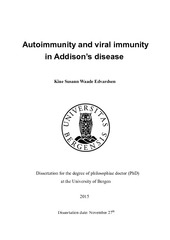Autoimmunity and viral immunity in Addison’s disease
Doctoral thesis
Permanent lenke
https://hdl.handle.net/1956/10940Utgivelsesdato
2015-11-27Metadata
Vis full innførselSamlinger
Sammendrag
Autoimmune Addison’s disease (AAD) is caused by an immunological destruction of the steroid producing cells of the adrenal cortex. Both genetic and environmental factors are involved in disease development, and while multiple studies have highlighted several genes linked to the disease, far less is known about possible environmental factors and the role played by the adrenal tissue itself. By studying the well-established human adrenocortical carcinoma cell line NCI- H295R as a model of the adrenal cortex, adrenal cells were shown to respond to environmental factors in the form of virus induced type I and III interferons (IFNs) by potentiating chemokine production and by upregulation of MHC class I and the tissue specific enzyme 21-hydroxylase (21OH). This can be important traits in the T cell- mediated adrenal tissue destruction, recruiting potentially 21OH-specific autoreactive T cells to the tissue. In addition, the same IFNs were shown to have a direct cytotoxic effect on the adrenocortical cells. From a large clinical material we have found that AAD patients have elevated levels of the chemokines CXCL10 and CXCL9 in their sera, while producing significantly lower levels of the same chemokines after stimulation of PBMC with type I and II IFNs and the TLR3 ligand poly (I:C). This is also the case when investigating the relative mRNA expression of selected IFN stimulated genes (ISGs) after IFN or poly (I:C) stimulation. Cytomegalovirus (CMV) has been implicated in autoimmune disease development, including AAD. Nevertheless, we found that AAD patients in general have normal humoral and cellular immunity towards CMV, with no differences in CD8+ T cell specific responses. However, the AAD patients were found to have significantly lower levels of total circulating CD8+ T cells. While CMV infections do not appear to be linked to AAD disease development in general, individual patients showed signs supporting CMV as a possible perpetrator. One patient had serological signs suggesting a reactivating CMV infection, while having extremely low levels of CMV specific CD8+ T cells. The same patient was also part of the chemokine study, where she had low chemokine production after IFN stimuli in addition to an upregulation of three ISGs in her peripheral blood. Intriguingly, the daughter of this patient also had AAD and, despite of being anti-CMV IgG positive, had virtually no CMV specific CD8+ T cells. These findings suggest that an inheritable immunological phenotype may increase individuals’ susceptibility to develop AAD, but also impair their ability to control viral infections. Taken together, the work included in this thesis provides important insight into AAD development. We have shown using adrenocortical cells that the adrenal cortex could play a part in its own destruction in response to interferons induced by viruses. Furthermore, while having a normal cellular and humoral immunity towards the common virus CMV, the innate immune system of AAD patients does not appear to function optimally. Thus for individual patients, CMV infection could be a precipitating event in disease development.
Består av
Paper I: A. Hellesen, K. Edvardsen, L. Breivik, E. S. Husebye and E. Bratland (2014) The effect of types I and III interferons on adrenocortical cells and its possible implications for autoimmune Addison’s disease Clinical and Experimental Immunology 2014 June 176(3): 351-362. This article is not available in BORA. The published version is available at: http://dx.doi.org/10.1111/cei.12291Paper II: K. Edvardsen, T. Bjånesøy, A. Hellesen, L. Breivik, M. Bakke, E. S. Husebye and E. Bratland (2015) Peripheral blood cells from patients with autoimmune Addison’s disease poorly respond to interferons in vitro, despite elevated serum levels of interferon-inducible chemokines Journal of Interferon & Cytokine Research 2015 May 15. [Epub ahead of print]. The article is available at: http://hdl.handle.net/1956/10855
Paper III: K. Edvardsen, A. Hellesen, E. S. Husebye and E. Bratland (2015) Analysis of cellular and humoral immune responses against cytomegalovirus in patients with autoimmune Addison’s disease. Manuscript. The article is not available in BORA.
